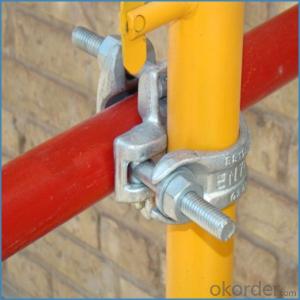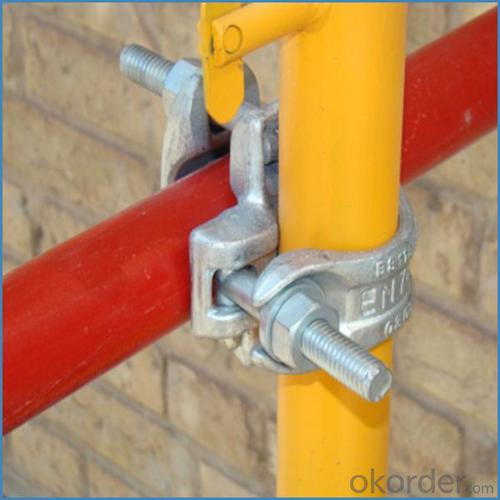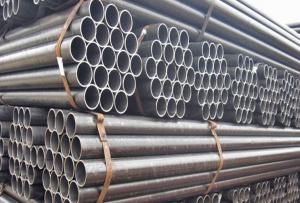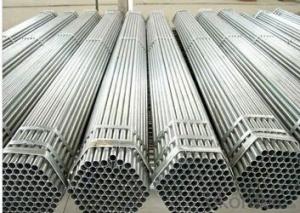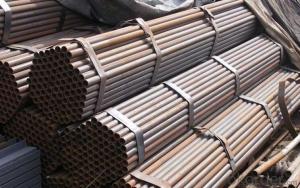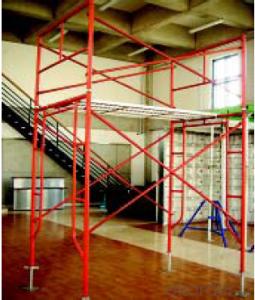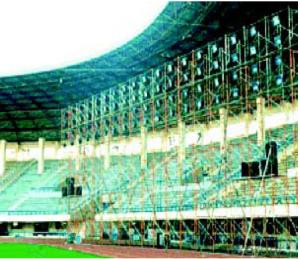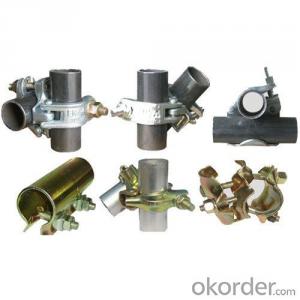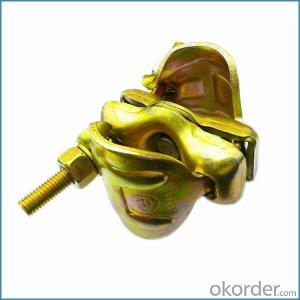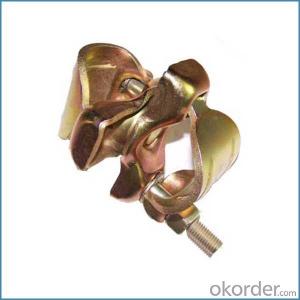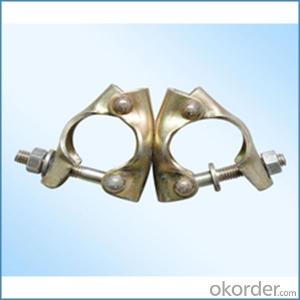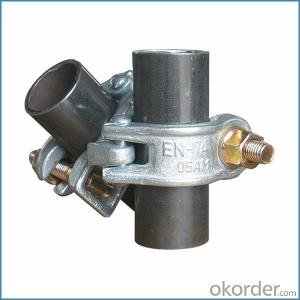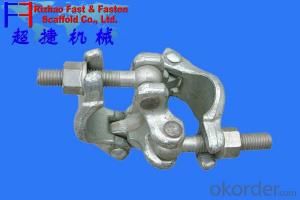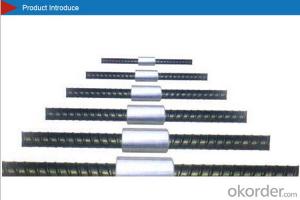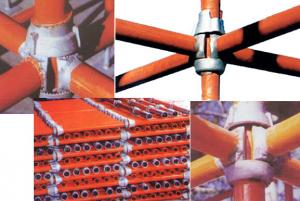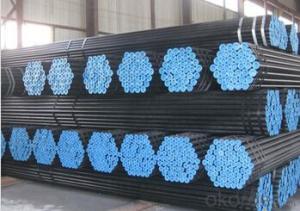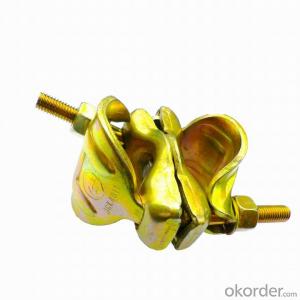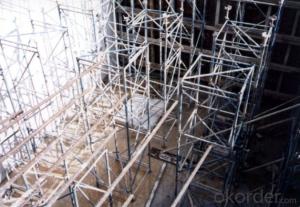Scaffolding Right-Angle Coupler British Type for Sale
- Loading Port:
- Tianjin
- Payment Terms:
- TT OR LC
- Min Order Qty:
- 1000 kg
- Supply Capability:
- 100000 kg/month
OKorder Service Pledge
OKorder Financial Service
You Might Also Like
Scaffolding Right-Angle Coupler British Type for Sale
Description
1.The scaffolding coupler is always used to connect the steel pipe as scaffolding system.
2.The often used coupler is swivel coupler and righ angle coupler .
3.We can provide types of scaffolding coupler according to your requirement.
4.Couoler can fix the 48.3mm scaffolding steel pipe tightly and make the whole scaffolding system more steadily.
5.Material:Q235 steel
6.Overall Size:48.3mm*48.3mm
7.Surface Finish: Galvanized/ Painted
8.Standard:BS1139,EN74
9.Package:25pcs/bag
10.Manufactuering as per customer requirements
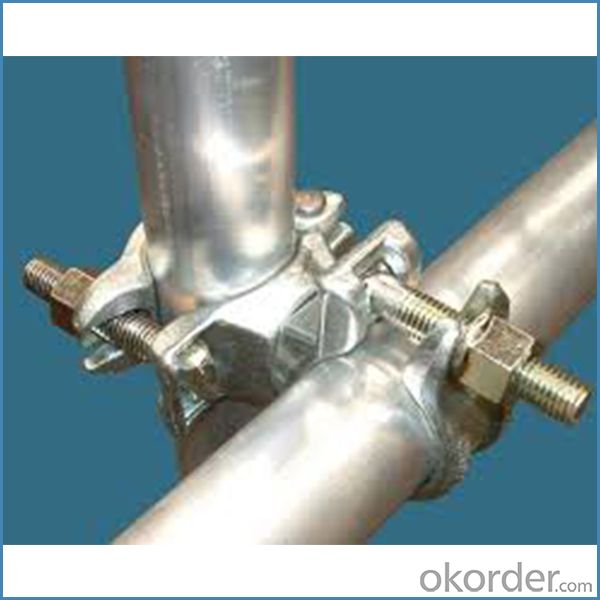
Feature
(1)Excellent Anti-Breaking—Cold Pressed Steel
(2)Outstanding Resistance Deformation
(3)Strong Anti-Dropping Ability
(4)Longtime USe
(5)Qualtity Guaranteed
(6)OEM Service
Photo
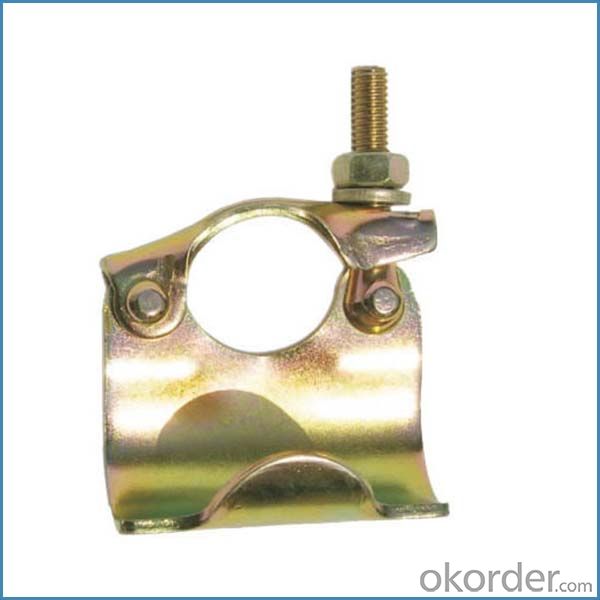
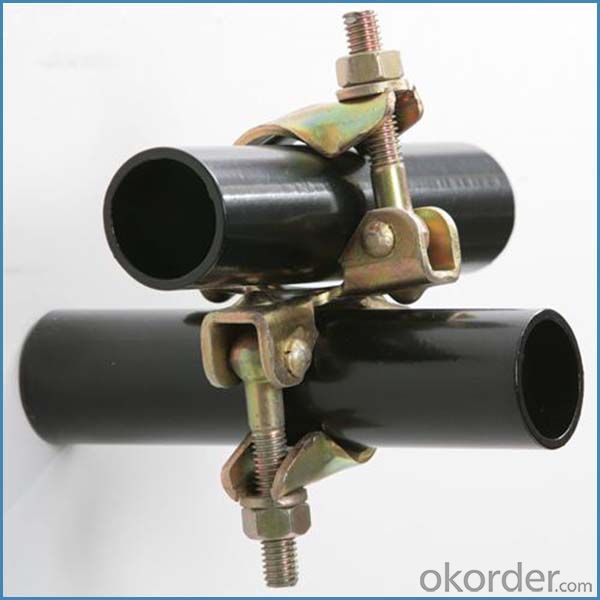
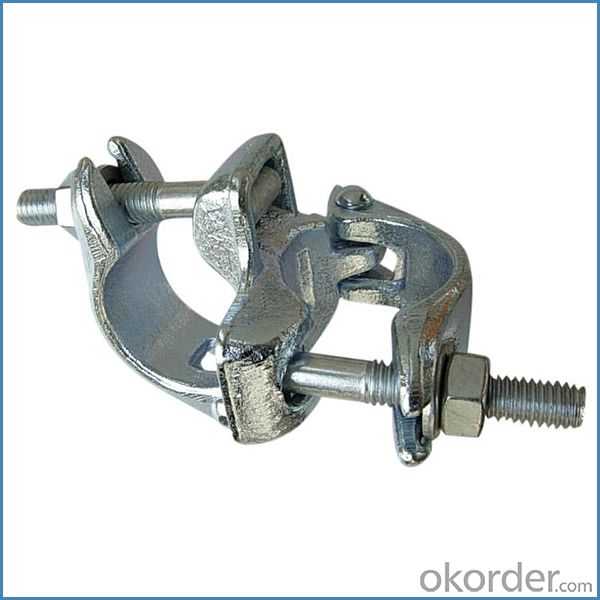
Parameter
| Material | Q235,345steel |
| Size | 48.3mm*48.3mm |
| Surface finish | Galvanized |
| Weight | 1.1kg around |
| Standard | BS1139,EN74 |
| Package | 25pcs/bag,steel pallet |
| Manufacture | As per customer requirement |
| Market | Africa, South America, the Middle East and Asia |
FAQ
Q: Are you a factory or trading company?
We are a state-owned corporation in China,dealing with various kinds of building materials.We have our holding subsidiaries.
Q: Where is your factory located? How can I visit there?
Our factory is located all around China.
Q: Can I get some samples?
Sample is free, customer only pay freight for the first time.
Q: Delivery?
10-30days. (5-15 containers)
Any question,feel free to contact us.
- Q: Construction When the fastener type steel pipe scaffold is only allowed to be used once
- Construction safety management system of enterprises in the first chapter at all levels of management of the safety of production responsibility The legal representative of the safety of production responsibilities Second, the enterprise technical person in charge of the safety of production three
- Q: Are steel tube couplers compatible with scaffolding systems that require quick assembly and dismantling?
- Yes, steel tube couplers are compatible with scaffolding systems that require quick assembly and dismantling. Steel tube couplers are widely used in scaffolding systems due to their ease of use and versatility. They are designed to connect steel tubes together securely, allowing for quick and efficient assembly and dismantling of scaffolding structures. Steel tube couplers provide a strong and stable connection, ensuring the safety and stability of the scaffolding system. Additionally, they are adjustable and can be easily tightened or loosened as needed, making them suitable for various scaffolding configurations. Overall, steel tube couplers are an excellent choice for scaffolding systems that require quick assembly and dismantling.
- Q: I'm a scaffold builder and have been doing it since 2004. I have been looking for jobs overseas and just have no luck. Can anyone help me please??
- Your question is not clear. Can you provide more details?
- Q: Are there any specific guidelines for the safe use of steel tube couplers in scaffolding near flammable or combustible materials?
- Yes, there are specific guidelines for the safe use of steel tube couplers in scaffolding near flammable or combustible materials. Here are some key guidelines to follow: 1. Conduct a thorough risk assessment: Before setting up scaffolding near flammable or combustible materials, it is crucial to conduct a risk assessment to identify potential hazards and develop appropriate control measures. 2. Maintain proper clearance: Ensure that the scaffolding is set up at a safe distance from any flammable or combustible materials. The specific clearance distance may vary depending on local regulations, but it is important to maintain a safe distance to prevent accidental ignition or fire spread. 3. Use non-sparking materials: When working near flammable materials, it is recommended to use steel tube couplers made of non-sparking materials. Non-sparking couplers are designed to reduce the risk of sparks that could potentially ignite flammable substances. 4. Implement fire prevention measures: Install fire prevention measures such as fire-resistant barriers or fire blankets between the scaffolding and flammable materials. These measures can help minimize the risk of accidental ignition or fire spread. 5. Control ignition sources: Take precautions to control potential ignition sources near the scaffolding. This includes prohibiting smoking, open flames, or any other activities that could produce sparks or heat that may ignite flammable materials. 6. Provide adequate training: Ensure that all workers involved in scaffolding operations near flammable or combustible materials receive proper training on fire safety, including the safe use of steel tube couplers and the procedures to follow in case of a fire emergency. 7. Regular inspections and maintenance: Regularly inspect the scaffolding, including the steel tube couplers, to ensure they are in good condition. Any damaged or faulty components should be replaced immediately to maintain safety. It is important to note that these guidelines may vary depending on local regulations and specific industry standards. Therefore, it is advisable to consult with relevant authorities or safety professionals to ensure compliance with all applicable guidelines and regulations.
- Q: How do steel tube couplers ensure the stability of scaffolding during adverse weather conditions?
- The stability of scaffolding in adverse weather conditions heavily relies on steel tube couplers. These couplers are essential for securely connecting and joining steel tubes, creating a durable structure that can withstand harsh weather elements like strong winds, rain, and snow. To begin with, steel tube couplers are constructed using top-notch steel, ensuring exceptional strength and durability. This enables them to endure the external forces exerted by adverse weather conditions without compromising the stability of the scaffolding. Their robust design prevents deformation or failure under pressure, establishing a solid foundation for the scaffolding system. Moreover, steel tube couplers are engineered with various mechanical features that enhance their resistance to adverse weather conditions. For instance, many couplers incorporate a threaded mechanism that facilitates a tight and secure connection between tubes. This threaded connection effectively eliminates any movement or shifting of the tubes, even when faced with strong winds or heavy rainfall. Additionally, certain couplers are equipped with locking devices or clamps that further reinforce the connection, adding extra stability. Furthermore, steel tube couplers are often galvanized, which involves coating them with a protective layer of zinc. This galvanized coating not only enhances their resistance to corrosion and rust but also provides an additional safeguard against adverse weather conditions. Acting as a barrier, the zinc layer prevents water or moisture from penetrating the couplers and causing any structural damage. In conclusion, steel tube couplers are crucial for maintaining the stability of scaffolding in adverse weather conditions. Their high-quality steel construction, mechanical features, and galvanized coating enable them to withstand external forces, preventing deformation or failure. Thanks to steel tube couplers, scaffolding remains stable and reliable, even when confronted with challenging weather conditions.
- Q: A man of mass 64.9 kg stands on a scaffold supported by a vertical rope at each end. The scaffold has a mass of 18.7 kg and is 3.3 m long. Suppose the man stands to the right from the middle of the scaffold that is a distance one sixth of the length of the scaffold. What is the tension in the right rope?
- take the left end as the hypothetical pivot then CCW torque = CW torque T*3.3 = (m g)_man * 2.2 + (m g)_scaffold * 1.65 3.3T = 2.2(64.9)(9.81) + 1.65(18.7)(9.81) = 1703.36 T = 516 N
- Q: Can steel tube couplers be used in high-temperature environments?
- In high-temperature environments, steel tube couplers generally have the ability to be used. However, it is crucial to take into account the specific temperature limits and the type of steel being utilized. There are certain steel tube couplers that are specifically engineered to endure high temperatures, while others may have restrictions. When choosing steel tube couplers for applications requiring high temperatures, it is vital to opt for those made from heat-resistant steel alloys that have the capacity to withstand the intended temperature range. These alloys are formulated specifically to maintain their strength and structural integrity even at elevated temperatures. Furthermore, factors such as the duration of exposure to high temperatures and the presence of other environmental factors like corrosion or thermal cycling should also be taken into consideration. Some steel tube couplers may have limitations regarding temperature range or may necessitate additional protection measures to guarantee their performance in high-temperature environments. To ensure the proper selection and utilization of steel tube couplers in high-temperature environments, it is advisable to seek consultation from manufacturers or industry experts who can provide guidance based on specific application requirements and the characteristics of the chosen steel tube couplers.
- Q: Can steel tube couplers be used for both indoor and outdoor scaffolding projects?
- Steel tube couplers are suitable for both indoor and outdoor scaffolding projects. Their purpose is to connect and secure scaffolding tubes, giving them stability and support. These couplers are made of high-quality steel, which ensures durability and resistance to different weather conditions. Regardless of whether it's an indoor or outdoor construction project, steel tube couplers can withstand the elements and create a reliable connection. However, it is crucial to properly maintain and protect the couplers from corrosion in outdoor projects. Moisture and other environmental factors can cause rusting and reduce their lifespan. In conclusion, steel tube couplers are versatile and can be used in both indoor and outdoor scaffolding projects.
- Q: What are the different types of steel tube couplers available?
- There is a variety of steel tube couplers to choose from, each with its own distinctive design and purpose. 1. Sleeve Couplers: The most commonly used steel tube couplers are sleeve couplers. They consist of a cylindrical sleeve with internal threads on both ends. By screwing the sleeve onto the threaded ends of the tubes, these couplers effectively join two steel tubes together. 2. Swivel Couplers: For connecting steel tubes at any angle, swivel couplers are the ideal choice. They have a swivel mechanism that allows for different orientations of the tubes. Swivel couplers find extensive use in scaffolding applications where flexibility in positioning is crucial. 3. Right-Angle Couplers: Designed specifically for connecting steel tubes at a 90-degree angle, right-angle couplers provide stability and rigidity in construction projects. With a fixed angle, they ensure a secure connection. 4. Putlog Couplers: When it comes to connecting steel tubes to walls or other structural elements, putlog couplers are the go-to option. They feature a flat plate with holes that are used to fasten the tube to the surface. In scaffolding systems, putlog couplers offer support and stability. 5. Half Couplers: To attach a steel tube to a flat surface, such as a wall or a beam, half couplers are the ideal solution. They have a flat plate with an opening that allows for the insertion of the tube, which can then be secured using bolts or screws. Half couplers find common use in construction projects that require the attachment of a tube to a fixed structure. 6. Beam Clamps: Beam clamps serve as specialized couplers for connecting steel tubes to beams or overhead structures. They feature a clamp mechanism that securely attaches them to the beam, providing a stable connection point for the tube. These examples highlight the diverse options available for steel tube couplers. The selection of the appropriate coupler depends on the specific application and project requirements. Ensuring a safe and secure connection between steel tubes necessitates the careful choice of the right coupler.
- Q: How do steel tube couplers prevent rotation or movement of scaffolding tubes?
- Scaffolding tubes can be prevented from rotating or moving by using steel tube couplers, which securely connect them at the joints. These couplers are specifically designed with a grip-like mechanism that tightly holds the tubes together, effectively preventing any rotation or movement. Comprising of two halves, the couplers are either bolted or welded together. Each half features a series of teeth or ridges on the inside. When the tubes are inserted into the coupler, these teeth or ridges grip onto the outer surface of the tubes, creating a strong and secure connection. The grip-like mechanism provided by the steel tube couplers ensures that the tubes remain fixed and stable, even when subjected to heavy loads or external forces. As a result, unwanted rotation or movement is prevented, ensuring the scaffold structure's integrity and safety. Furthermore, the steel construction of the couplers contributes to their strength and durability. Steel is renowned for its robustness and resistance to bending or deformation, making it an ideal material for scaffolding applications. Consequently, the couplers possess enhanced capabilities to prevent rotation or movement of the scaffolding tubes. By effectively securing the joints, steel tube couplers play a vital role in providing stability and rigidity to scaffolding structures. They ensure that the tubes remain in place, creating a safe and reliable platform for workers to carry out tasks at various heights.
Send your message to us
Scaffolding Right-Angle Coupler British Type for Sale
- Loading Port:
- Tianjin
- Payment Terms:
- TT OR LC
- Min Order Qty:
- 1000 kg
- Supply Capability:
- 100000 kg/month
OKorder Service Pledge
OKorder Financial Service
Similar products
Hot products
Hot Searches
Related keywords
